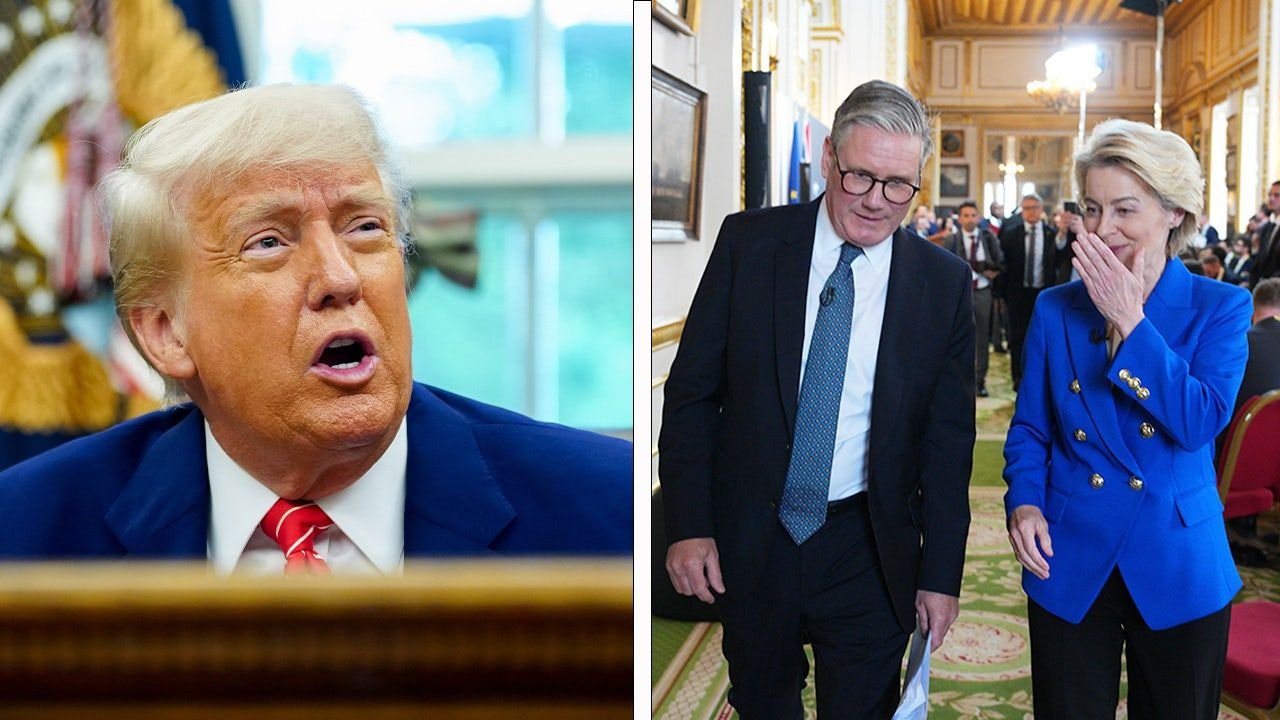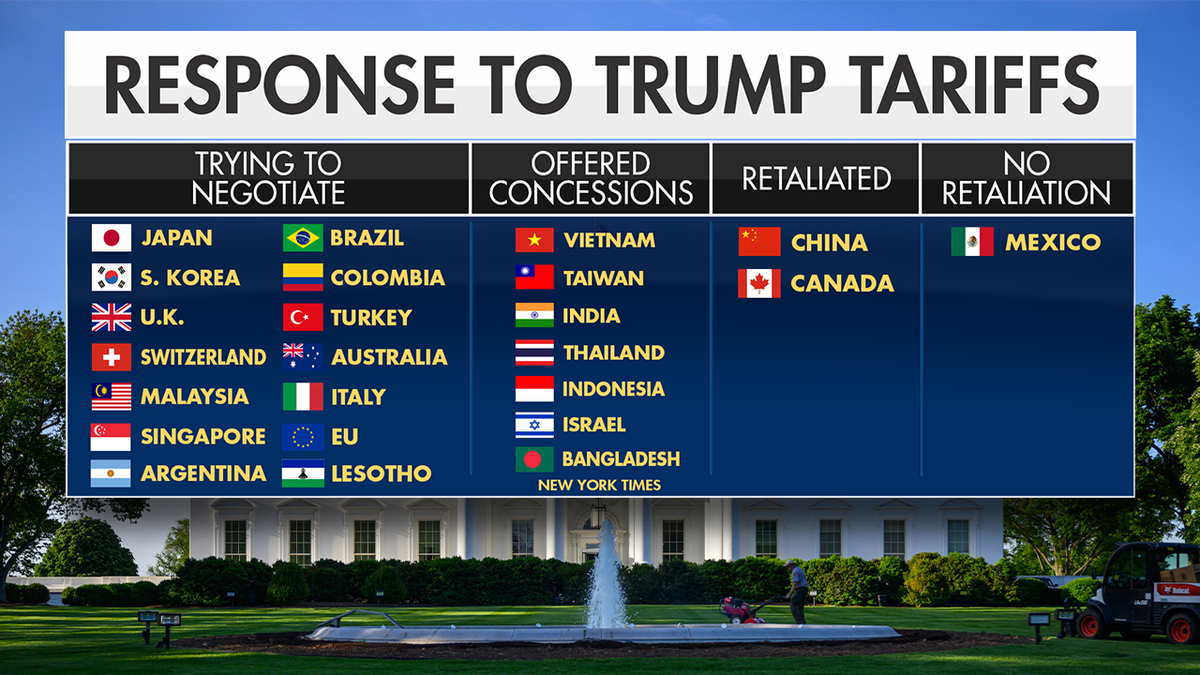INTERNACIONAL
Trump’s tough policies push UK, EU to significantly expand trade and defense

Nearly a decade after the United Kingdom (U.K.) voted to leave the European Union (EU) under Brexit and amid shifting relations with the U.S. under President Donald Trump, Britain and the EU significantly bolstered their trade and defense partnership on Monday.
In what is the largest deal the bloc and the U.K. have agreed to since the controversial Brexit vote in 2016, the two economic powerhouses agreed to increase defense ties and slash red tape, making it not only easier for U.K. food and visitors to access the continent, but also granting fishing rights to EU vessels off of Britian’s coastline.
The agreements have been described as a «reset» and championed by U.K. Prime Minister Kier Starmer, who opposed Brexit, and EU leader, Commission President Ursula von der Leyen, who said, «At a time of global instability, and when our continent faces the greatest threat it has for generations, we in Europe stick together.»
TRUMP IS COMMITTED TO 10% BASELINE TARIFF, WHITE HOUSE SAYS, DESPITE UK TRADE DEAL ANNOUNCEMENT
Britain’s Prime Minister Keir Starmer, center, stands for a photo with European Commission President Ursula von der Leyen and European Council President Antonio Costa ahead of a United Kingdom and European Union summit at Lancaster House in London on Monday, May 19, 2025. (Henry Nicholls/Pool Photo via AP)
While the U.K. talked down the Trump administration’s 25% «reciprocal» tariffs earlier this month to limit the fees to 10% on up to 100,000 car exports to the U.S. – the U.K.’s chief export item to the States – the EU has reached no such agreement with Washington and faces 20% tariffs on all U.S. exports come July.
While EU and U.S. officials are still working to find an agreement, reports on Monday suggested that even the existing 10% tariff slapped on the EU over the last 50 days has left a negative mark and the bloc anticipates a drop in growth for 2025.
However, it is not only Trump’s tariffs that have pushed Western allies to strengthen relations following his re-entry into the White House.
ZELENSKYY SPEAKS WITH TRUMP, ALLIES AFTER RUSSIA PEACE TALKS BROKER NO CEASEFIRE

A Fox News graphic that depicts how countries have responded to President Donald Trump’s tariffs. (Fox News / MANDEL NGAN/AFP via Getty Images)
Trump’s hardline push for increased NATO defense spending, along with his sharp break from the Biden administration on Ukraine aid, left European allies scrambling after his inauguration.
While the Trump administration has seemingly improved ties with Ukrainian President Volodymyr Zelenskyy, Trump’s refusal to outright condemn Russian President Vladimir Putin has resulted in stronger ties between top nations like the U.K., France and Germany, as well as within the EU bloc.
At the heart of the new defense agreement is the U.K.’s ability to access an EU defense loan program worth roughly $170 billion, expanding joint defense procurement opportunities.

From left to right, Polish Prime Minister Donald Tusk, Ukrainian President Volodymyr Zelenskyy, U.K. Prime Minister Keir Starmer, French President Emmanuel Macron and German Chancellor Friedrich Merz arrive to put flowers on memorial of fallen Ukrainian soldiers at Independence Square in Kyiv, Ukraine, on Saturday, May 10, 2025. Ukrainian first lady Olena Zelenska is seen behind, second right. (AP Photo/Evgeniy Maloletka)
CLICK HERE TO GET THE FOX NEWS APP
«Britain is back on the world stage,» Starmer said. «This deal is a win-win.»
Far-right conservatives in the UK like Nigel Farage, an ardent proponent of BREXIT, have condemned the recently announced deal.
The White House did not immediately respond to Fox News Digital’s questions.
Reuters contributed to this report.
INTERNACIONAL
Netanyahu se reunió con los enviados de Trump en medio de la crisis que amenaza la tregua en Gaza

El primer ministro israelí, Benjamin Netanyahu, se reunió el lunes con los emisarios estadounidenses Steve Witkoff y Jared Kushner después del estallido de hostilidades en Gaza que amenazan la tregua impulsada por el presidente Donald Trump.
“El primer ministro Netanyahu se encontró hoy con el enviado especial Steve Witkoff y el yerno del presidente Trump, Jared Kushner, para abordar los eventos y novedades en la región”, dijo Shosh Bedrosian, portavoz de la oficina del dirigente israelí.
La visita de los emisarios a Tel Aviv se produce un día después de que el frágil acuerdo enfrentara su primera crisis importante, cuando Israel amenazó con detener las transferencias de ayuda humanitaria luego de que militantes de Hamás mataran a dos soldados israelíes, según informó el ejército israelí.
El portavoz de Netanyahu también anunció una visita “de varios días” a Israel del vicepresidente estadounidense, JD Vance, y su esposa. “Se reunirán con el primer ministro”, afirmó.
La embajada de Estados Unidos confirmó que los dos enviados habían aterrizado en Tel Aviv. Más tarde, el ejército israelí anunció que reanudó la aplicación del alto el fuego, y un funcionario confirmó que las entregas de ayuda se reanudarían el lunes. A primera hora de la tarde, no estaba claro de inmediato si el flujo de ayuda se había restablecido.
Han pasado más de una semana desde el inicio de la tregua propuesta por Estados Unidos, destinada a poner fin a dos años de guerra. El presidente Trump dijo a periodistas a bordo del Air Force One el domingo que Hamas ha estado “bastante alborotado” y “han estado disparando”.
También sugirió que la violencia podría ser culpa de “rebeldes” dentro de la organización en lugar de su liderazgo.
Desde que comenzó el alto el fuego, las fuerzas de seguridad de Hamas han regresado a las calles de Gaza, enfrentándose con grupos armados y matando a presuntos delincuentes en lo que el grupo terrorista dice que es un intento de restaurar la ley y el orden en áreas donde las tropas israelíes se han retirado.
El domingo, el ejército israelí informó que militantes habían disparado contra tropas en áreas de la ciudad de Rafah que están bajo control israelí según las líneas del alto el fuego acordadas.
Hamas, que continuó acusando a Israel de múltiples violaciones del alto el fuego, dijo que la comunicación con sus unidades restantes en Rafah había estado cortada durante meses y que “no somos responsables de ningún incidente que ocurra en esas áreas”.
Las próximas etapas del alto el fuego se espera que se centren en el desarme de Hamas, la retirada israelí de áreas adicionales que controla en Gaza y el futuro gobierno del devastado territorio. El plan estadounidense propone el establecimiento de una autoridad respaldada internacionalmente.
En una entrevista con “60 Minutes” durante el fin de semana, Kushner dijo que el éxito o fracaso del acuerdo dependerá de si Israel y el mecanismo internacional pueden crear una alternativa viable a Hamas. “Si tienen éxito, Hamas fracasará y Gaza no será una amenaza para Israel en el futuro”, afirmó.
Mientras tanto, una delegación de Hamas liderada por el negociador jefe Khalil al-Hayya estaba en El Cairo para hacer seguimiento de la implementación del acuerdo de alto el fuego con mediadores y otros grupos palestinos.
Un funcionario de seguridad israelí dijo el lunes a la agencia AP que la ayuda continuaría ingresando a Gaza a través de Kerem Shalom y otros cruces después de la inspección israelí, en línea con el acuerdo. El funcionario habló bajo condición de anonimato de acuerdo con las regulaciones militares.
En su ataque del 7 de octubre de 2023 contra Israel que desencadenó la guerra, terroristas liderados por Hamas mataron a alrededor de 1.200 personas, en su mayoría civiles, y secuestraron a 251 personas como rehenes.
La guerra entre Israel y Hamas ha matado a más de 68.000 palestinos, según el Ministerio de Salud de Gaza, que no distingue entre civiles y combatientes en su recuento. Miles más están desaparecidos, según la Cruz Roja.
Diplomacy / Foreign Policy,North America,WASHINGTON
INTERNACIONAL
In Photos: Bernie Sanders, costumed demonstrators rally against Trump at No Kings Day protest

NEWYou can now listen to Fox News articles!
politics,donald trump,bernie sanders,us protests
INTERNACIONAL
El nuevo presidente de Bolivia: Rodrigo Paz, el trotamundos del «capitalismo para todos»

Heredero de una influyente dinastía política de Bolivia, Rodrigo Paz rehúye el membrete ideológico. Cuando cierra sus mítines, reparte lemas para todos: desde el conservador «dios, familia, patria» hasta el guevarista «hasta la victoria siempre». Es el candidato que promete cambiar el sistema y a la vez no afectar a nadie.
Hijo del expresidente Jaime Paz Zamora (1989-1993), tuvo que empezar varias veces de cero porque su familia se veía obligada a viajar de un lado a otro, a menudo perseguida por dictaduras militares.
Hijo de la española Carmen Pereira y del expresidente boliviano Jaime Paz Zamora (1989-1993), el aun senador opositor nació en Santiago de Compostela en 1967 y vivió su niñez en varios países debido a que sus padres fueron perseguidos durante los gobiernos militares.
El político es economista y tiene estudios en relaciones internacionales, además de una amplia experiencia en el sector público al haber sido diputado, concejal, alcalde de la ciudad sureña de Tarija entre 2015 y 2020 y actualmente es senador por la fuerza opositora Comunidad Ciudadana (CC), del expresidente Carlos Mesa (2003-2005).
Para llegar a la Alcaldía de Tarija, Paz derrotó en las elecciones municipales de 2015 al gubernamental Movimiento al Socialismo (MAS), entonces liderado por el expresidente Evo Morales (2006-2019).
En 2019, fue parte de la llamada Coordinadora de la Defensa de la Democracia que exigió que haya una segunda vuelta electoral, en medio de las denuncias de un fraude a favor del entonces mandatario Morales y en desmedro de Carlos Mesa en los fallidos comicios generales de ese año, posteriormente anulados.
El éxito de Paz en la primera vuelta fue atribuido por expertos a la conexión que logró con las clases populares en las áreas rurales y zonas periurbanas, espacios donde en las elecciones pasadas triunfó el MAS, que en los comicios de agosto apenas logró el 3% requerido para no perder la sigla.
Ese respaldo fue trabajado por el opositor desde su llegada al Senado, pues en sus redes sociales se puede constatar que desde 2021 recorrió numerosos municipios bolivianos, 220 según asegura él mismo, llegando incluso a participar activamente en fiestas patronales populares y desfiles folclóricos junto a distintos sindicatos.
Otros atribuyen ese apoyo a su compañero de fórmula en el Partido Demócrata Cristiano (PDC), el excapitán de policía Edman Lara, quien se hizo popular en las redes sociales por sus revelaciones de supuestos casos de corrupción en la institución policial, hasta que en 2024 fue dado de baja.
La faceta de trotamundos la retomó durante su campaña electoral. El economista de 58 años señala que recorrió cientos de municipios de Bolivia en cinco años. «No soy un candidato de hace seis meses«, asegura.
Compite para administrar este país en crisis de 11,3 millones de habitantes contra el expresidente de derecha Jorge Quiroga, tras 20 años de gobiernos socialistas iniciados por Evo Morales.
«Mi voto de confianza es por Rodrigo Paz (…). Es una renovación», dice Walter López, abogado de 27 años, a la puerta de un local de campaña del Partido Demócrata Cristiano-afiliado a la centroderecha-, que cobija su candidatura.
Pero Paz no es nuevo en política. Fue diputado, alcalde y ahora es senador por Tarija, un departamento rico en gas y petróleo, del que su familia es oriunda.
En su linaje también aparece su tío, el guerrillero Néstor Paz, que murió de inanición luego de un combate, y su tío abuelo Víctor Paz Estenssoro, cuatro veces presidente y artífice del voto universal y la reforma agraria.
El parecido con su padre, las cejas pobladas y su intenso pelo negro, funciona como un catalizador nostálgico para los viejos izquierdistas. En algunos de sus videos en redes sociales, donde es muy activo, también ha hecho aparecer al patriarca de 86 años.
Pero él propone un «capitalismo para todos». «No tengo por qué definirme, sino ofrecer al país una alternativa», replicó en una entrevista con CNN cuando le pedían definiciones ideológicas.
Paz llegó al balotaje de manera inesperada, ganador de la primera vuelta. Las encuestas lo situaban entre el tercer y quinto puesto una semana antes de esa elección. En su programa «capitalismo para todos», Paz promete fuertes recortes del gasto público, formalización de la economía y cambios de la Constitución para abrir el país a las inversiones privadas. «Yo espero entrar a gobernar, tomar las decisiones adecuadas. Y no a la reelección, que venga otro», dijo a la AFP.

 CHIMENTOS1 día ago
CHIMENTOS1 día agoLa fuerte actitud de Manu Urcera con Indiana Cubero que reveló la verdad de la interna familiar: “El saludo del piloto a la hija de Nicole Neumann por su cumpleaños”

 POLITICA3 días ago
POLITICA3 días agoDenunciaron a dos periodistas por “inducir al engaño” a los votantes de La Libertad Avanza

 POLITICA2 días ago
POLITICA2 días ago“El Pollo” Carvajal revela cómo Chávez pagaba a Kirchner, Lula y Petro con dinero del narcotráfico















